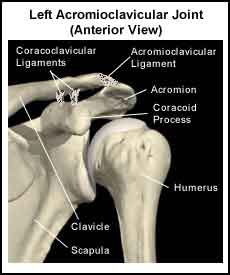In order to understand this condition, it is important to understand the anatomy and function of the shoulder. Please read Shoulder Pain Info’s section on basic shoulder anatomy. For additional background information on the biomechanics of the shoulder please read Shoulder Pain Info’s section on basic shoulder biomechanics.

What is the anatomy of the acromioclavicular (AC) joint?
The shoulder complex is made up of three bones, which are connected by muscles, ligaments, and tendons. The large bone in the upper arm is called the humerus. The shoulder blade is called the scapula and the collarbone is called the clavicle.
The acromioclavicular joint of the shoulder complex is where the outer (distal) part of the clavicle is joined to a projection on the top of the scapula known as the acromion process. The joint connecting these two bones is known as the acromioclavicular (AC) joint. The AC joint allows a small amount of movement to occur between clavicle and the acromion process.
Ligaments are like strong ropes that help connect bones and provide stability to joints. In the AC joint there are three main ligaments. The acromioclavicular ligament connects the acromion process and the clavicle. The coracoclavicular ligaments (the trapezoid ligament and conoid ligament) connect the clavicle with another projection of the scapula called the corocoid process.
What is AC joint osteoarthritis?
The word arthritis means inflammation (swelling) of a joint. Osteoarthritis, also known as “wear and tear” arthritis is the most common type of arthritis. It is estimated that osteoarthritis affects one out of every ten Canadians and that 85% of Canadians over the age of 70 will have osteoarthritis.
Osteoarthritis affects the articular cartilage of the AC joint. Articular cartilage is the smooth coating that covers the surface of the bones of the AC joint. Articular cartilage also cushions and helps lubricate the joint surfaces (see the anatomy section for further information about articular cartilage). In osteoarthritis the articular cartilage begins to degrade. Over time the articular cartilage becomes thinner or forms cracks. Pieces of cartilage may come loose and float within the AC joint, further irritating the joint. After a long period of time the cartilage can become completely “worn away” and the bones can begin to rub together.
What causes AC joint osteoarthritis?
No one knows for sure what causes osteoarthritis of the AC joint but some risk factors include:
- Previous shoulder injury or surgery ie. AC joint separation.
- Family history of osteoarthritis.
- Damage to the shoulder from another type of arthritis.
- Increasing age.
What does AC joint osteoarthritis feel like?
Osteoarthritis of the AC joint usually comes on slowly and results in shoulder pain, stiffness and/or swelling. The pain is felt in the area of the AC joint. Sometimes a grating sound can be heard when the shoulder moves – such as when reaching overhead. Bumps or nodes may appear around the AC joint. Sometimes an AC joint can have a mild amount of osteoarthritis and feel perfectly fine.
Can AC joint osteoarthritis be detected on X-rays?
X-rays are an effective tool for identifying AC joint osteoarthritis. X-rays detect narrowing of the AC joint, which occurs as a result of wearing out of the articular cartilage. An M.R.I. may be required to rule out bone spurs pressing on the rotator cuff tendons or the subacromial bursa (impingement syndrome). Sometimes blood tests are ordered to rule out infection or other types of arthritis.
What is the treatment for AC joint osteoarthritis?
A lot can be done to help people who have osteoarthritis in their AC joint. Most types of treatment work best when started early, before there is a lot of “wear and tear” in the joint. The goal of treatment is to reduce pain and maintain or improve mobility of the shoulder.
Every osteoarthritic AC joint is different, and there should be a team approach to treatment. Some available treatments include strengthening and stretching exercises, rest or activity modification, heat/cold therapy, acetaminophen (Tylenol) or anti-inflammatory medications or a cortisone injection. In severe cases of AC joint osteoarthritis, when conservative treatment fails, a surgical procedure to remove the arthritic end of the clavicle is required. Doctors and physical therapists who deal with people who have osteoarthritis of the AC joint can help outline a treatment program.
What other information is available on AC joint osteorarthritis
There are some great books available on Osteoarthritis:
